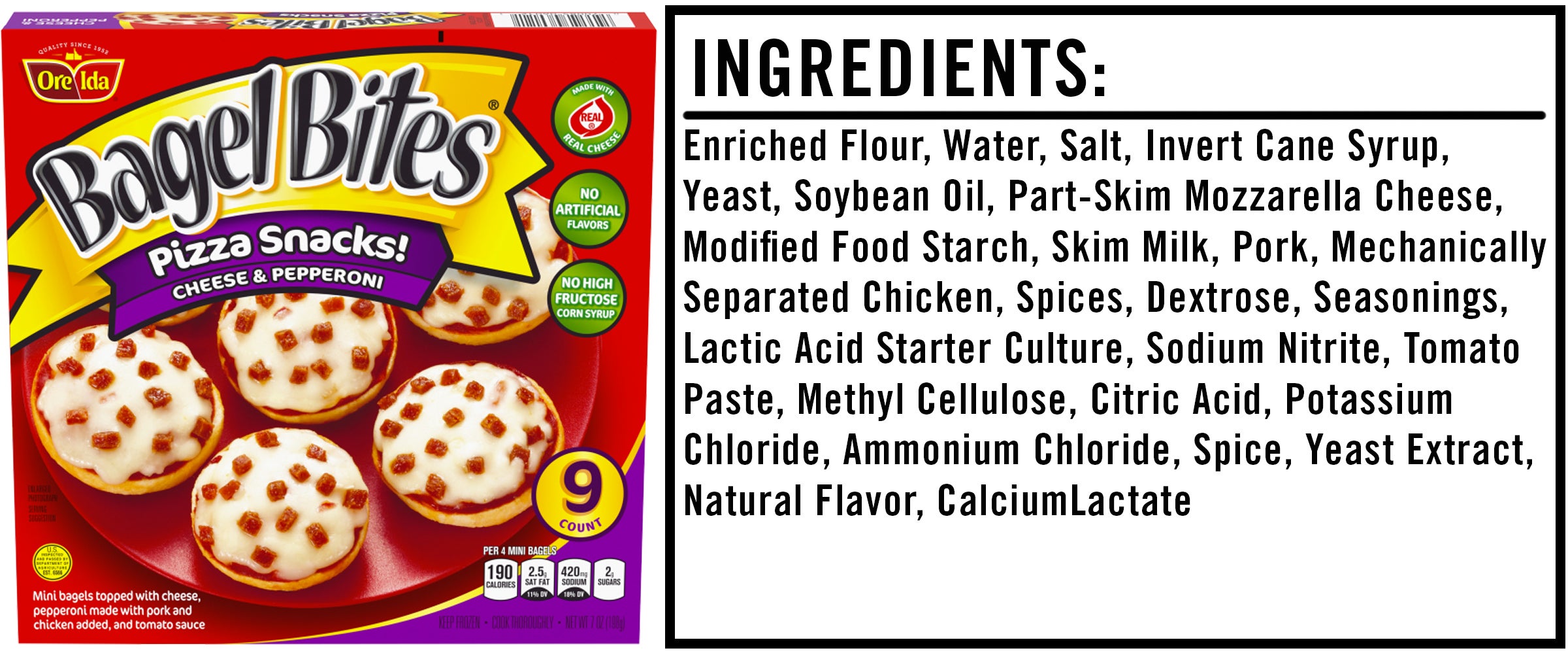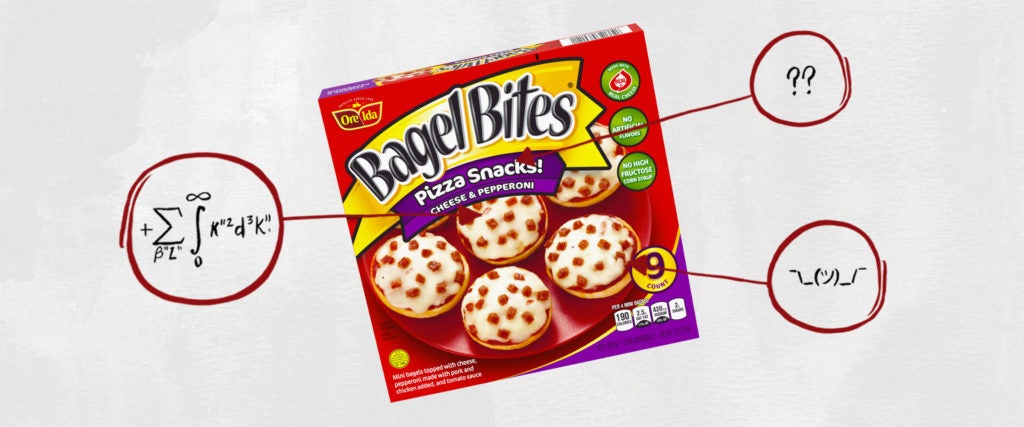We’re often told that you should never eat anything (or put anything on your body) if you don’t recognize everything on the ingredients list. But since most of us have no idea what xanthan gum or potassium benzoate are — or more importantly, what they’re doing to our bodies — we’re decoding the ingredients in the many things Americans put in (and on, or near) themselves.
This edition: Cheese & Pepperoni Bagel Bites, which are made from more than 30 ingredients that we’ve broken down as they appear on the Bagel Bites website. Note that the Bagel Bites ingredients have been organized by which part of the Bagel Bites they can be found in.

Bagel Bites Ingredients: The Bagel Halves
1) Enriched Flour (Wheat Flour, Enzyme, Ascorbic Acid, Niacin, Reduced Iron, Thiamine, Mononitrate, Riboflavin, Folic Acid): As we learned in our exploration of the many, many, many ingredients in the McDonald’s Big Mac, enriched flour is far less “enriched” than the name would have you believe. In addition to containing more calories than whole wheat flour, the bleaching process enriched flour often undergoes produces an unfortunate byproduct: A chemical called alloxan, which has been found to induce diabetes in lab-animal test subjects by destroying their pancreas.
2) Water: Together, water and flour make dough.
3) Salt: Salt enhances the flavor. Now, the Bagel Bites website claims they contain no sodium whatsoever, which is blatantly untrue. So I turned elsewhere: According to the Walmart website, one serving of four Bagel Bites delivers 410 milligrams of sodium, or 17 percent of your daily recommended intake (less than I expected, actually).
4) Invert Cane Syrup: Invert cane syrup is a liquid sweetener made from granulated table sugar and water. It can be especially useful in baked goods because of its ability to retain moisture. Once again, the Bagel Bites website fails us, claiming they contain no sugar whatsoever. But Walmart says they boast two grams per serving — not all that much.
5) Yeast: The fungus that makes dough rise.
6) Soybean Oil: Consumed in large amounts, soybean oil can cause all sorts of problems, including fatty liver disease, insulin resistance and migraines.
Bagel Bites Ingredients: The Cheese Blend
1) Part-Skim Mozzarella Cheese (Part-Skim Milk, Cheese Cultures, Salt, Enzymes): As physician and biochemist Cate Shanahan explained to us during our analysis of Doritos, suspicious-seeming ingredients, like “cheese cultures” and “enzymes,” are actually nothing to worry about: “Starter cultures and enzymes are just used to accelerate the process of coagulating milk into cheese. Pretty much all cheese is made using some kind of enzyme to speed up the fermentation process.”
2) Modified Food Starch: Modified food starch is extracted from the source (usually corn, potatoes and/or tapioca), then treated physically, enzymatically or chemically to partially break down the starch. It likely adds some bulk to this cheese.
3) Skim Milk: Milk with the cream removed.
Bagel Bites Ingredients: The Diced Pepperoni Made with Pork, Chicken and Smoke Flavor Added
1) Pork: It would be near impossible to say for certain which parts of the pig are in these miniature pepperoni pieces, since the Department of Agriculture appears to be fairly lenient when it comes to pizza toppings — if Bagel Bites even count as pizza. Its Food Standards and Labeling Policy Book, the only real stipulation I could find, states that “up to 25 percent of Meat Block” used to produce meat toppings on pizza may contain partially defatted chopped pork or beef, which are byproducts produced from fatty trimmings containing less than 12 percent lean meat. All in all, it would be fair to say that your local butcher would be less than impressed by this pork.
2) Mechanically Separated Chicken: Mechanically separated chicken is a paste created by pressing unstripped chicken bones through a sieve to separate edible meat tissue (including tendons and muscle fibers) from the bones. Uh, yum?
3) Salt: More flavor.
4) Spices: What these spices are remains a mystery, because as we learned in our exploration of the ingredients in nacho-flavored Doritos, the FDA doesn’t require food labelers to list each spice by their specific name (as a means of protecting their recipes) so long as it follows their definition of the word “spice”: “The term spice means any aromatic vegetable substance in the whole, broken or ground form, except for those substances which have been traditionally regarded as foods, such as onions, garlic and celery; whose significant function in food is seasoning rather than nutritional; that is true to name; and from which no portion of any volatile oil or other flavoring principle has been removed.”
5) Water: Just some more H2O.
6) Dextrose: Dextrose is a sugar derived from starches, like corn. Fun fact: Dextrose has an especially high glycemic index, meaning it quickly raises blood sugar levels, so it’s used in IV solutions to treat low blood sugar and dehydration. People with diabetes might also consume dextrose tablets to raise their blood sugar levels if they become dangerously low. Because of this blood-sugar-boosting effect, consuming dextrose also provides an almost immediate jolt of energy — and then an inevitable crash.
7) Seasonings (Natural Spice Extractives, Extractives of Paprika, Natural Smoke Flavor, BHA, BHT and Citric Acid): Taking these one at a time, natural spice extractives are exactly what they sound like: Concentrated spices. Extractives of paprika, meanwhile, are likely added to color the meat more red.
To create natural smoke flavor, wood is burned at high temperatures, and the resulting smoke particles are collected in condensers. That liquid is then concentrated, creating a relatively strong smoky flavor.
BHA, or butylated hydroxyanisole, is a common preservative added to prevent products from spoiling. “In lower levels — like those found in foods — some researchers consider BHA to be perfectly safe,” nutritionist David Friedman, author of Food Sanity: How to Eat in a World of Fads and Fiction, previously told us. “On the flip side, the National Toxicology Program has concluded that BHA ‘is reasonably anticipated to be a human carcinogen.’” Generally speaking, BHA is probably worth avoiding as best you can.
BHT, or butylated hydroxytoluene, is another common preservative added to prevent products from spoiling. Studies continue to go back and forth about whether or not it’s carcinogenic, so it’s hard to say whether the amounts in Bagel Bites would cause you any harm.
Finally, citric acid naturally occurs in citrus fruits and is often added to foods to extend their shelf life.
8) Lactic Acid Starter Culture: Lactic acid starter cultures are natural preservatives derived from vegetable sources, like beets or corn.
9) Sodium Nitrite: “Sodium nitrite stabilizes the red color in cured meats, which prevents the meat from naturally turning gray,” Dagan Xavier, ingredient expert and co-founder of Label Insight, told us while we were exploring the ingredients in frozen breakfast sandwiches. “Adding nitrite to food can lead to the formation of small amounts of nitrosamines (a carcinogen).”
Bagel Bites Ingredients: Sauce
1) Water: Just more water.
2) Tomato Paste: Tomato paste provides tomato flavor. Duh.
3) Invert Cane Syrup: See above.
4) Modified Food Starch: See above.
5) Salt: Yep, more salt.
6) Methyl Cellulose: Methyl cellulose is produced by chemically treating the natural cellulose found in plants and is often used as a thickener.
7) Citric Acid: See above.
8) Potassium Chloride: Potassium chloride is added to food for two reasons: 1) To act as a salt substitute; and 2) to enhance the amount of potassium, an essential and widely under-consumed nutrient, found in the product. While small amounts shouldn’t do you any harm, Friedman previously warned us of consuming too much of the stuff. “Potassium chloride is used to induce cardiac arrest during executions by lethal injections,” he said. “That should speak volumes as to whether this ingredient belongs in our food supply.”
9) Ammonium Chloride: In Bagel Bites, ammonium chloride is likely used as an acidifier and generally recognized as safe.
10) Spice: See above.
11) Yeast Extract: Made from the same yeast used to make bread, yeast extract can be used to create an umami flavor, similar to MSG.
12) Natural Flavor: Natural flavors are flavors derived from an actual food source, like tomato flavoring taken from an actual tomato.
13) Calcium Lactate: Commonly used as a calcium supplement, calcium lactate can also help regulate acidity levels.
Bagel Bites Ingredients: More Ingredients
1) Water: Even more water.
2) Invert Cane Syrup: See above.
The Takeaway
Personally, I have several problems with the ingredients in Bagel Bites. For one, the invert cane syrup is unnecessary all around and only really serves to add unhealthy sugar to something that should already taste fine. Furthermore, the meat used on these Bagel Bites simply cannot be trusted, especially considering how many carcinogenic preservatives they add to keep it from going nasty. All in all, you’d be much better off slapping some tomato sauce, cheese and deli meat on a bagel to make your own Bagel Bites.

